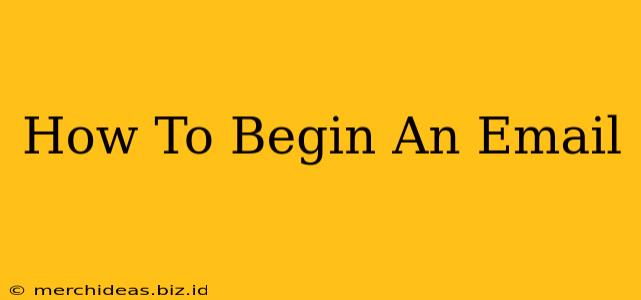Starting an email might seem simple, but a strong opening line sets the tone and determines how your message will be received. A poorly crafted introduction can lead to your email being ignored or deleted before it's even read. This guide will help you master the art of email introductions, ensuring your message gets the attention it deserves.
Understanding Your Audience: The Key to a Great Opening
Before you even think about writing your opening line, consider who you're emailing. Are you contacting a potential client, a colleague, a friend, or a family member? The appropriate opening will vary greatly depending on your relationship with the recipient and the context of your email.
Professional Emails: First Impressions Matter
For professional emails, aim for conciseness and clarity. Avoid overly casual greetings. Here are some effective opening lines for professional communication:
- "Subject Line Reiteration": If your subject line clearly states your purpose, you can simply reiterate it briefly. For example, if your subject is "Meeting Request - Project X," you might begin with, "Following up on my previous email regarding Project X..."
- "Direct and to the Point": Clearly state your purpose immediately. For example, "I'm writing to request..." or "I'm following up on..."
- Personalized Greeting + Purpose: Combine a personalized greeting with a clear statement of purpose. For example, "Dear Mr./Ms. [Last Name], I'm writing to inquire about..."
Avoid: Overly familiar greetings like "Hey" or "What's up?" unless you have an established, informal relationship with the recipient.
Casual Emails: Keeping it Friendly
For emails to friends and family, a more casual approach is perfectly acceptable. However, even informal emails benefit from a clear opening:
- Simple Greetings: "Hi [Name]," or "Hey [Name]," work well.
- Referencing a Previous Conversation: "Following up on our chat yesterday..."
- Contextual Opening: "Just wanted to let you know..." or "Hope you're having a great week!"
Avoid: Beginning with only an emoji or a single word.
Beyond the Greeting: Setting the Stage
Once you've chosen your greeting, it's crucial to immediately state the purpose of your email. Don't keep the recipient guessing. This provides context and encourages them to read further. Think of it as a mini-elevator pitch for your email's content.
Effective Email Opening Strategies
- Highlight the Benefit: Focus on what the recipient will gain from reading your email. For example, instead of "I'm writing to ask for a favor," try "I have an idea that could significantly improve our project efficiency."
- Use a Question: A well-crafted question can pique the recipient's interest and encourage a response. For instance, instead of "I'm sending you the report," try "Have you had a chance to review the latest project report?"
- Share a Relevant Anecdote: If appropriate, start with a brief, relevant anecdote to connect with the recipient on a personal level.
Things to Absolutely Avoid
- Generic Openings: Avoid clichés like "I hope this email finds you well." While polite, these phrases are often overlooked.
- Long-Winded Introductions: Get straight to the point. Avoid unnecessary details or rambling sentences.
- Negative or demanding tone: Start with a positive and respectful tone. Avoid phrases like "You must..." or "You need to..."
The Power of Proofreading
Before hitting send, always proofread your email. Typos and grammatical errors can create a negative impression. Take a moment to review your opening line and ensure it is clear, concise, and professional (or appropriately casual, depending on your audience).
By following these guidelines, you'll significantly improve your email communication, ensuring your messages are read, understood, and acted upon. Mastering the art of the email opening is a crucial skill in both professional and personal communication.
